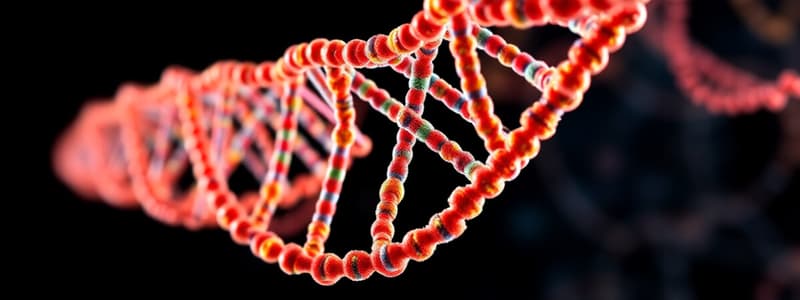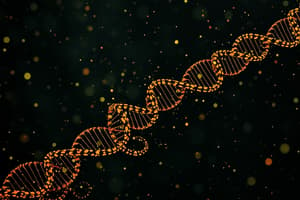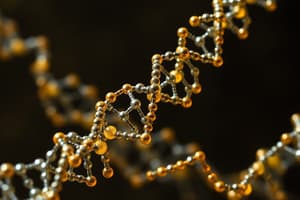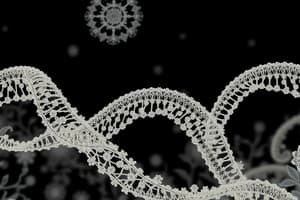Podcast
Questions and Answers
What is the primary purpose of genome assembly?
What is the primary purpose of genome assembly?
- To perform gene expression analysis
- To fragment the genome into smaller pieces
- To reconstruct the genome from sequenced fragments (correct)
- To sequence chromosomes from end to end
Genome assembly is typically achieved by sequencing a single copy of a genome.
Genome assembly is typically achieved by sequencing a single copy of a genome.
False (B)
What does the Lander-Waterman equation help estimate?
What does the Lander-Waterman equation help estimate?
The depth of coverage required for genome sequencing.
The formula for the Lander-Waterman equation is C = LN/G, where C stands for the genome ______.
The formula for the Lander-Waterman equation is C = LN/G, where C stands for the genome ______.
Match the following terms with their descriptions:
Match the following terms with their descriptions:
Which of the following is a reason why genome assemblies might be fragmented?
Which of the following is a reason why genome assemblies might be fragmented?
DNA minimizers are used to increase the complexity of genome assembly.
DNA minimizers are used to increase the complexity of genome assembly.
What impact does increased sequencing have on genome assembly?
What impact does increased sequencing have on genome assembly?
What is a major issue when assembling genomes related to repeats?
What is a major issue when assembling genomes related to repeats?
Larger k-mer sizes always lead to a better genome assembly.
Larger k-mer sizes always lead to a better genome assembly.
What does DBG stand for?
What does DBG stand for?
As the value of k increases, fewer k-mers will __________ between reads due to sequencing errors.
As the value of k increases, fewer k-mers will __________ between reads due to sequencing errors.
Which of the following is a disadvantage of high k-mer values?
Which of the following is a disadvantage of high k-mer values?
Repetitive sequences cannot cause misrepresentation in genome structure.
Repetitive sequences cannot cause misrepresentation in genome structure.
What is one major source of issues during genome assembly according to the provided content?
What is one major source of issues during genome assembly according to the provided content?
The complexity of the genome can lead to __________ during the assembly process.
The complexity of the genome can lead to __________ during the assembly process.
What type of graph traversal does a Hamiltonian path involve?
What type of graph traversal does a Hamiltonian path involve?
What does C represent in the Poisson probability distribution for sequencing?
What does C represent in the Poisson probability distribution for sequencing?
In a Poisson distribution, the probability of sequencing a base only once at 10X coverage is 0.00045.
In a Poisson distribution, the probability of sequencing a base only once at 10X coverage is 0.00045.
What type of graph is used to resolve sequence assembly by reducing redundant edges?
What type of graph is used to resolve sequence assembly by reducing redundant edges?
The nodes in a De Bruijn graph represent sequences of a fixed size, known as a ______.
The nodes in a De Bruijn graph represent sequences of a fixed size, known as a ______.
Which of the following statements about k-mer size in De Bruijn graphs is correct?
Which of the following statements about k-mer size in De Bruijn graphs is correct?
The traversal of a De Bruijn graph requires alignment of reads to generate sequences.
The traversal of a De Bruijn graph requires alignment of reads to generate sequences.
What happens to nodes with an in-degree and out-degree of one in a string graph?
What happens to nodes with an in-degree and out-degree of one in a string graph?
The probability of sequencing a base at a $10X$ coverage can be calculated using the formula $P(Y=y) = (C^y * e^{-C})/y!$ where y represents the ______.
The probability of sequencing a base at a $10X$ coverage can be calculated using the formula $P(Y=y) = (C^y * e^{-C})/y!$ where y represents the ______.
What is a common result of using an excessively small k-mer size in sequencing?
What is a common result of using an excessively small k-mer size in sequencing?
What does phased assembly primarily achieve in genomic studies?
What does phased assembly primarily achieve in genomic studies?
Increasing the coverage of a genome will always reduce the error rate of the assembly to zero.
Increasing the coverage of a genome will always reduce the error rate of the assembly to zero.
What are the two main approaches to phasing genomes?
What are the two main approaches to phasing genomes?
In the theorem proposed by Gene Myers, perfect assembly is possible if the errors are ______, sampling is ______, and reads are long enough to solve ______.
In the theorem proposed by Gene Myers, perfect assembly is possible if the errors are ______, sampling is ______, and reads are long enough to solve ______.
Match the sequencing conditions with their descriptions:
Match the sequencing conditions with their descriptions:
Which step is NOT included in the four core steps of modern genome assembly?
Which step is NOT included in the four core steps of modern genome assembly?
Using genetic mapping populations is common for phasing in animal species.
Using genetic mapping populations is common for phasing in animal species.
What is the primary challenge in achieving perfect DNA assembly with current technology?
What is the primary challenge in achieving perfect DNA assembly with current technology?
Which of the following methods uses SMS reads for mapping but employs high quality reads for accurate base calling?
Which of the following methods uses SMS reads for mapping but employs high quality reads for accurate base calling?
Minimizers are larger sets of kmers selected from a read to represent the read effectively.
Minimizers are larger sets of kmers selected from a read to represent the read effectively.
_______ construction is one of the four core steps involved in modern assemblies of genomes.
_______ construction is one of the four core steps involved in modern assemblies of genomes.
Why is using trios sequencing data beneficial for phasing?
Why is using trios sequencing data beneficial for phasing?
What is the purpose of using minimizers in DNA assembly?
What is the purpose of using minimizers in DNA assembly?
The process of selecting a minimizer involves choosing the smallest kmer from a set of adjacent kmers called _______.
The process of selecting a minimizer involves choosing the smallest kmer from a set of adjacent kmers called _______.
Flashcards
Genome Assembly
Genome Assembly
The process of piecing together fragmented DNA sequencing reads to create a complete picture of a genome.
Genome Fragmentation
Genome Fragmentation
DNA is broken into smaller pieces before sequencing.
Sequencing Coverage (C)
Sequencing Coverage (C)
The amount of DNA sequenced relative to the total DNA in the genome.
Lander-Waterman Equation
Lander-Waterman Equation
Signup and view all the flashcards
DNA Minimizers
DNA Minimizers
Signup and view all the flashcards
Sequencing Read
Sequencing Read
Signup and view all the flashcards
Genome Chromosome
Genome Chromosome
Signup and view all the flashcards
Genome Coverage equation
Genome Coverage equation
Signup and view all the flashcards
Sequencing Coverage
Sequencing Coverage
Signup and view all the flashcards
Poisson Distribution
Poisson Distribution
Signup and view all the flashcards
String Graph
String Graph
Signup and view all the flashcards
Transitive Reduction
Transitive Reduction
Signup and view all the flashcards
Eulerian Path Problem
Eulerian Path Problem
Signup and view all the flashcards
De Bruijn Graph
De Bruijn Graph
Signup and view all the flashcards
K-mer
K-mer
Signup and view all the flashcards
Over-connectivity (De Bruijn Graph)
Over-connectivity (De Bruijn Graph)
Signup and view all the flashcards
Unitig
Unitig
Signup and view all the flashcards
Genome Coverage (Sequencing)
Genome Coverage (Sequencing)
Signup and view all the flashcards
What is a minimizer?
What is a minimizer?
Signup and view all the flashcards
Why are minimizers helpful for assembly?
Why are minimizers helpful for assembly?
Signup and view all the flashcards
How are minimizers used in DNA assembly?
How are minimizers used in DNA assembly?
Signup and view all the flashcards
What is a de Bruin Graph (DBG)?
What is a de Bruin Graph (DBG)?
Signup and view all the flashcards
What is MinimizerDBG?
What is MinimizerDBG?
Signup and view all the flashcards
De Bruijn Graph Assembly
De Bruijn Graph Assembly
Signup and view all the flashcards
Genome Assembly Fragmentation
Genome Assembly Fragmentation
Signup and view all the flashcards
Repeat Collapse
Repeat Collapse
Signup and view all the flashcards
Ambiguous Paths
Ambiguous Paths
Signup and view all the flashcards
High k-mer Value
High k-mer Value
Signup and view all the flashcards
Insufficient Coverage
Insufficient Coverage
Signup and view all the flashcards
Error Rate (Sequencing)
Error Rate (Sequencing)
Signup and view all the flashcards
Eulerian Path
Eulerian Path
Signup and view all the flashcards
Hamiltonian path
Hamiltonian path
Signup and view all the flashcards
Phased Assembly
Phased Assembly
Signup and view all the flashcards
Assembly-based phasing
Assembly-based phasing
Signup and view all the flashcards
Alignment-based phasing
Alignment-based phasing
Signup and view all the flashcards
Perfect DNA Assembly
Perfect DNA Assembly
Signup and view all the flashcards
Random Errors
Random Errors
Signup and view all the flashcards
Reproducible Errors
Reproducible Errors
Signup and view all the flashcards
Poisson Sampling
Poisson Sampling
Signup and view all the flashcards
Repeat Resolution
Repeat Resolution
Signup and view all the flashcards
Read Length
Read Length
Signup and view all the flashcards
Repeat Resolution with Sufficient Read Length
Repeat Resolution with Sufficient Read Length
Signup and view all the flashcards
Study Notes
Lecture 5 - DNA Assembly
- The lecture covers DNA assembly, a bioinformatics process
- The goal is constructing a complete genome from fragmented sequencing reads
- The process involves several steps, starting with DNA sequencing, quality control, assembly, genome annotation, and analysis
- Various algorithms are used for DNA sequencing read assembly
- Coverage is an important factor influencing assembly accuracy
- Assemblies are often fragmented due to limitations in sequencing technology
- Repeats in the genome pose challenges for correct assembly
- Sequencing errors contribute to assembly fragmentation
- Diploid/polyploid organisms further complicate assembly
Lander-Waterman Equation
- An equation estimating the sequencing depth needed for genome assembly reaching a specific confidence level
- The equation (C = LN/G) considers genome coverage (C), read length (L), the number of reads generated (N), and genome size (G)
- Sequencing coverage is a measure of how many times a particular base is sequenced
- The calculation uses Poisson probability distribution
Lander-Waterman Limitations
- Assumes uniform coverage across the genome, but in reality, coverage varies
- Does not account for repeats, which are common in genomes. Repeats make it difficult to uniquely assemble genome regions
- Ignores sequencing errors that are introduced by the sequencing technology
- Assumes a haploid genome, despite most organisms having multiple copies
- Errors are not always random, the technology introduces biases
Genome Assembly Process
- The process involves assembling overlapping DNA sequences into contigs
- Contigs are then linked into scaffolds based on sequence similarities
- Scaffolds are positioned in pseudo-chromosomes based on physical location
Real-Life Complications
- Sequencing technologies introduce errors, these are context dependent
- Genomes evolve through duplication and deletion as well as mutation, making some regions difficult to uniquely identify
- It is not feasible to sequence every base in a large genome; not all parts are represented with the same frequency
Duplication Solutions
- Greater read length & read pairs provide improved results
Simple Repeats Solution
- Read length is the only practical solution at this stage
- Read pair distance is only a rough estimate, not an accurate solution
Genome Assembly Approaches
- Greedy assembly
- String graph assembly
- De Bruijn graph assembly
Greedy Algorithm
- A 'greedy' algorithm, Overlap-Layout-Consensus (OLC) is used to create assemblies
- OLC algorithms calculate nucleotide identity (overlap) between all pairs of reads
- A graph is constructed where each node represents a read and weighted edges between them represent their overlap quality
OLC continued
- Most OLC algorithms visit each node once
- Optimal path identification involves ordering and aligning overlapping regions of reads to construct a consensus sequence
- The complexity increases significantly with longer reads and more errors
Overlap Layout Consensus
- Example of how fragments share sequence in an assembly (layout graph of fragments)
String Graph
- Improvement over OLC algorithms (which is greedy)
- String graph algorithms examine and incorporate repetitive regions
- Algorithms use transitive reduction to compress repetitive regions
De Bruijn Graph Assembly
- Nodes represent kmers (short DNA sequences)
- Edges connect kmers that are adjacent in the original sequence
- Traversing the graph allows reconstructing the original sequence
De Bruijn Graphs and K-mer Size Impact
- Too small k-mer size leads to over-connectivity and collapsing of repeats
- Too large k-mer size leads to fewer overlaps and inaccurate assemblies
DBG Advantages
- Reduces computation time by not requiring explicit sequence-to-sequence overlap calculations
- The final sequence is generated by traversing the graph
Why are Assemblies Fragments?
- Sequencing technology limitations/weaknesses result in fragmented assemblies
- Complexity of the genome, particularly repeats, complicates assembly
Hamiltonian vs Eulerian
- Hamiltonian: Passes through each node once, but not necessarily all edges. More difficult to determine
- Eulerian: Passes through each edge once, but can visit a node multiple times. Algorithms exist to efficiently determine viability
Phased Assembly
- Separates maternally and paternally inherited chromosomes into haplotypes
- Helps with complex genome analysis of diploid or polyploid organisms
- Two main approaches exist: assembly-based phasing & alignment-based phasing
Genome Assembly
- Modern assemblies have four core steps (data pre-processing, contig construction, scaffolding, and gap closure)
- Specialized software handles these steps
The Perfect DNA Assembly?
- The current technology cannot achieve a perfect DNA assembly. Multiple conditions must be met (random errors, sampling is poisson, reads long enough to handle repetitions)
a) Errors Random
- As sequencing coverage increases, assembling errors become less impactful
- Non-random (reproducible) errors limit assembly quality despite increased coverage
b) Sampling is Poisson
- If sequencing coverage is sufficient, every region of the genome can be adequately covered.
- This relies on a Poisson sampling distribution
c) Reads Long Enough to Solve Repeats
- Sufficient read length helps resolve repeats and improves assembly
- Repeat resolution is crucial for accurate genome assembly
Can PacBio Achieve Perfection?
- PacBio technology has potential but challenges remain, particularly handling diploid/polyploid organisms, lengthy/noisy reads, and error rates
- Improvements in assembling error-prone reads are needed
Assembly with Long Reads
- Technologies focus on long read sequencing and assembly
- Three approaches include direct, hybrid, and hierarchical assemblies
Challenges of SMS de novo
- High error rates affect k-mer-based assemblies
- First whole-genome assemblies took significant computation time
- Newer software has improved assembly speed
DNA Minimizers
- Subsequences selected (kmers) to represent the read
- A smaller subset of kmers to reduce computational resources
- Minimizers are useful for identifying overlaps between sequences
DNA Minimizers 2
- Methods like BWT-FM kmer search to locate minimizers
- Minimizers for error-prone sequences
Minimizer DBG
- Minimizer DBG is a computational approach for assembling DNA sequences based on minimizers
- Utilizes error-corrected reads and minimizes the computational resources
- Can be used for assembly, error correction, and pan-genome assembly
Evaluating a DNA Assembly
- Metrics such as N50, NG50, L50 provide a measure of assembly quality
- Additional metrics include coverage and the number of contigs
- Tools for analysis include QUAST & BUSCO
Tools for Evaluating DNA Assembly
- QUAST: Quality assessment of assemblies. Provides metrics such as N50, L50, mis-assemblies, and completeness
- BUSCO: Benchmarking universal single-copy orthologs. Evaluates the quality of genome assemblies through assessing coverage by checking for the presence of highly conserved single-copy ortholog genes
Studying That Suits You
Use AI to generate personalized quizzes and flashcards to suit your learning preferences.




